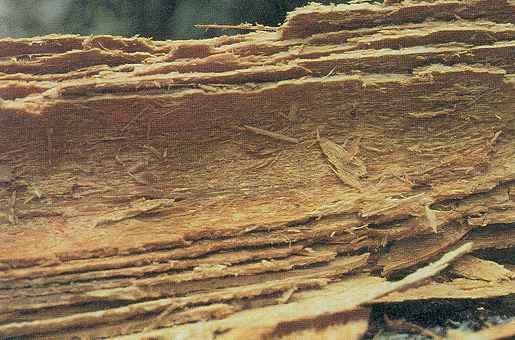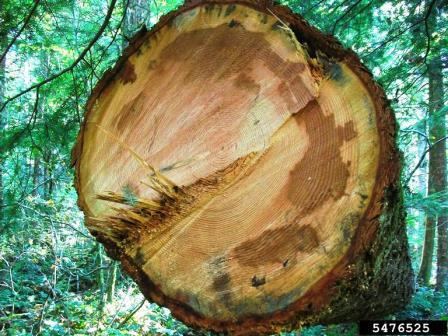Kingdom Fungi Class Basidiomycetes | Phylum Basidiomycota | |
 | ||
Similar Phellinus weirii, Phellinus, Phaeolus schweinitzii, Phellinus pini, Heterobasidion annosum | ||
Douglas fir with laminated root rot
Laminated root rot also known as yellow ring rot is caused by the fungal pathogen Phellinus weirii. Laminated root rot is one of the most damaging root disease amongst conifers in northwestern America and true firs, Douglas-fir, Mountain hemlock, and Western hemlock are highly susceptible to infection with P. weirii. A few species of plants such as Western white pine and Lodgepole pine are tolerant to the pathogen while Ponderosa pine is resistant to it. Only hardwoods are known to be immune to the pathogen.
Contents
- Douglas fir with laminated root rot
- Detroit lake laminated root rot meeting with rangers
- Symptoms and Signs
- Discovery
- Disease Cycle and Transmission
- Management
- Economic importance
- References

Detroit lake laminated root rot meeting with rangers
Symptoms and Signs

The disease can infect trees as young as 6 years-old, and infects trees throughout their lifespan. Diagnostic symptoms include crown yellowing and thinning, a distress crop of cones, red brown stained outer heartwood, and laminate decay (decay that separates along annual rings). The disease tends to occur in patches due to a primarily short range spread mechansism. Infected or decayed roots break close to the root collar forming “root balls.” Laminated root rot is frequently detected during ground survey when canopy openings and standing dead and fallen trees are observed. Signs of laminated root rot include the setal hyphae (tiny hairlike hyphae) between sheets of decomposing wood and also buff colored mycelium on the outside of the roots.
Discovery

The fungus Phellinus weirii was first discovered in 1914, on Western red cedar in Idaho. The first reported instance in Douglas-fir was in 1940, in Cowichan Lake, British Columbia.
Disease Cycle and Transmission

There are two types of the Phellinus; one that causes laminated root rot in Douglas fir, Grand fir, and Hemlocks and the other that causes butt rot in Western red cedar. The mycelium of this fungus doesn’t grow in the soil and also its spores are not spread by wind like most fungal pathogens. Infection occurs when roots of healthy trees grow in contact with infected roots. After initial contact with a living root, the mycelium grows on the bark, extending only a few millimeters into the surrounding soil. The mycelium penetrates the host through injured bark and advances proximally and distally along newly infected roots. It eventually penetrates through the host’s cambium and grows inside the wood causing decay and death of living cells in the heartwood and sapwood. During this process of entering into the cambium, the pathogen kills the phloem and initiates the decay of the xylem. The pathogen utilizes both cellulose and lignin, weakening the plant and eventually this leads to its death Phellinus Weirii over-winters within infected stumps and can remain viable for up to 50 years It is also known to infect bark, but this infection process is not well understood. Older trees are more resilient to infection, although trees of all ages may be infected.
Management

In all cases of the disease, thorough study of the distribution and intensity should be determined to help choose a management practice that’s cost effective. For example, if the disease is widespread in a pre-commercial stand, destroying the plantation may be the most effective measure. The area can then be replanted with immune or low-susceptible species. Aerial surveying is a viable tool available for use in areas where there are severely damaged systems. Other management tools include:

Economic importance
The trees die from failure to take up water and nutrients because of the main roots are decayed. The death is also accelerated by wind that throws the trees down. It is estimated that Laminated root rot reduces timber production by about 4.4 million cubic meters annually. Wood losses in British Columbia are estimated to be 1.4 million cubic meters.
